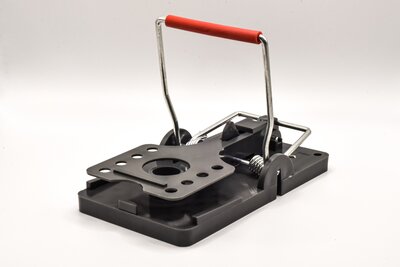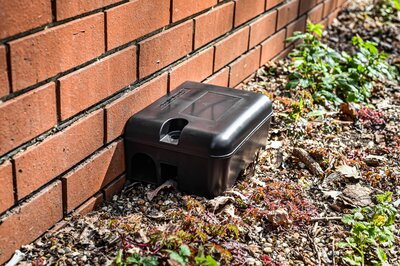How to Get Rid of Roof Rats
Table of Contents
- 5 Tips for Getting Rid of Roof Rats
- How to Identify Roof Rats in Your Home
- What is a Roof Rat?
- Evidence of Roof Rats
- How Do Roof Rats Get Into a House?
- Finding Roof Rats in the Attic
- How to Get Rid of Roof Rats
- Prevention: What Can I Do to Keep Roof Rats Out of My House?
- How Can I Prevent Future Problems With Roof Rats?
5 Steps for Getting Rid of Roof Rats
Dealing with roof rats? You’re not alone—these sneaky pests are notorious for invading attics, chewing through wiring, and contaminating food.
If roof rats have already infested your property, here are five steps to help you get rid of them:
Step 1: Protective Gear Recommendations
Protective gear can protect you from dust, insulation particles, rat droppings, urine, or fleas.
Here are some recommendations:
- Gloves. Wear thick, disposable gloves (nitrile or rubber) to protect your hands from rat droppings, urine, and trap handling.
- Respirator or N95 Mask. Attics can be filled with dust, insulation fibers, and potentially harmful airborne particles from rat waste. An N95 mask or respirator helps prevent inhalation of contaminants.
- Safety Goggles. Protect your eyes from dust, debris, or any unexpected rodent movement.
- Long-Sleeved Shirt & Pants. Wear durable, tight-fitting clothes to minimize skin exposure. Avoid loose clothing that could snag on insulation or wood.
- Hat or Hood. This helps keep insulation, dust, and rodent debris from getting into your hair.
- Sturdy, Closed-Toe Shoes. Thick-soled shoes provide better footing and protection against exposed nails or unstable surfaces.
Here are some additional tips:
- Bring a Flashlight or Headlamp. Attics are dark, and you’ll need good visibility to place traps properly.
- Use Knee Pads or a Cushion. Crawling in an attic can be rough on your knees.
- Disinfect & Wash Up Afterward. After setting traps, wash your hands thoroughly and consider showering to remove contaminants.
- Step on the Floor Joists. It can be tricky but move about on the floor joists, the horizontal pieces of wood on the attic floor. If you misstep, you could crack your ceiling drywall.
Step 2: Set Up Traps & Bait Stations
The most effective approach to capture and exterminate roof rats is with snap traps or bait stations.
Snap Traps

Classic snap traps can be effective but need careful placement and baiting. Roof rats are wary, so choose enticing baits like peanut butter, nuts, or dried fruit.
Rats are color-blind and don't see well. As such, Position traps along known rat pathways, such as near walls.
Pro tip: Wait a few days after baiting the trap before activating it. This strategy can increase your chances of catching rats and make them think the traps are safe.
Important: Snap traps can be dangerous. Handle them with gloves and keep them out of reach of children and pets.
Bait stations

Rat bait stations can be another great tool. You can bait a station with a rodent bait block from your local hardware store. Or you can bait the stations with peanut butter, nuts, chocolate, and fruit.
What about rat poison and rodenticide? That's a good question. Call a local pest control company to see if they recommend these baits. The EPA restricts the use of rat poison.
You can also set up several bait stations along the perimeter of your home. Bait stations should be placed no more than 40 feet apart
Step 3: Remove Food & Water Sources
Believe it or not, rats eat many of the same foods you (and your pets) eat. Rats love fruit, berries, nuts, grains, seeds, and pet food.
Store your food in air-tight containers, and don't leave pet food out overnight.
What about food outside my home? Great question - we recommend:
- Stop filling the birdfeeder for a time
- Trim overhanging fruit tree branches over your home
- Dispose of dropped fruit around your home
- Dispose of acorns and yard waste
The idea is to eliminate the outside food sources as much as possible to avoid luring rats to your home.
Step 4: Seal Entry Points
Did you know rats can get through openings as small as a nickel? Their bodies are slender, but often their fur is so greasy they can slide through just a half-inch wide openings. Yuck!
Inspect your home for openings that rats could use to enter. Pay close attention to gaps around pipes, vents, windows, and doors. Seal these entry points with steel wool, caulk, or wire mesh.
Step 5: Call a Pest Control Company
Hopefully, these DIY tips can help you get rid of roof rats. Whether you're in doubt or these don't work, don't feel ashamed to call a pest control company.
A professional rodent control company will detect invading roof rats and determine how to remove them. Then, they'll devise a solution to prevent their return.
How to Identify and Get Rid of Roof Rats in Your Home
If you're experiencing any problems with the roof rats you should hire professionals to perform inspections and roof repairs to find the rodent entry points. The entrances can be completely closed by having the roof repaired or replaced. That's the first step in getting rid of them.
What Is A Roof Rat?
Roof rats are pesky rodents that find refuge in your home. Also known as ship rats, black rats, or fruit rats, roof rats were given their name because of most often found building their homes on the upper levels of structures. They can spread deadly diseases, cause house fires, and create other problems in your home. Though some individuals find the small paws and dark fur of these rats endearing, they are not a species you want living in your quarters.
What Do They Look Like?
Larger than mice, roof rats measure about 6-8 inches in length, not including the tail, whereas mice measure only about 3 inches in length, again not including the tail. Roof rats are slenderer than mice and have big ears and eyes, a pointed snout, a long tail, and black or brown fur. Their fur tends to be smooth and silky, but their tails are scaly with no fur. If you are confused about whether you are seeing a rat or a mouse, heed the size of the animal's body. That will be a key indicator to help you distinguish between the two rodent types.
Habits Of The Rats
Because they are scavengers looking for a food source, roof rats pick up and spread a lot of diseases. This means that when they rummage through your food at night-due to being nocturnal creatures-they contaminate it as well as other areas they spend time in. They can also ruin solid materials, such as electrical wires, by gnawing through them.
Even if you only have a few roof rats initially, you're likely to have many roof rats within a short time frame. This is due to females reaching sexual maturity in 68-90 days. Once they can get pregnant, they do so quickly and can have 4-6 litters each year with 5-8 pups per litter. In other words, like rabbits, they multiply rapidly. So, you will want to remove them as soon as you find them.
Evidence Of Roof Rats
Roof rats tend to be good at evading humans, so the best way to detect a rodent infestation is not necessarily by seeing them yourself.
Consequently, the best way to detect them is to keep an eye out for any of the following signs in your home or on your property:
- Droppings: Roof rat droppings are capsule-shaped and have blunt ends. The feces range from about 1/4 to 1/2 inch in length, which means they are larger than mouse droppings and tend to be shiny black in color. The coloring may differ, however, depending on the diet of the rats. Roof rat droppings are about three times bigger than typical house mice droppings.
- Urine Stains and Odors: If you see rodent urine, you may have roof rats. Their urine is most easily spotted using a UV-ray flashlight. So, if you detect the odor of urine but do not see any visible evidence, try shining a UV light in the region you believe urine to be in. It will look like tiny droplets or streaks.
- Gnawing Holes: Roof rats love to chew on wood, but they will also bite electrical wiring, food packaging, and other materials. The openings they create are around or even larger than 2 inches in diameter and have rough edges.
- Tracks: Roof rats will make pathways, also known as runways or tracks, which show their activities. Indoor tracks will look like clean routes through dirt or dust, ranging from 3/4 to 1 inch wide. Tracks on walls may have grease stains next to them. Outdoor tracks will look smooth and have a well-packed surface devoid of vegetation or foliage.
- Sights and Sounds: Because these rodents scavenge at night, they sleep during the day when humans are awake. Additionally, they hide while they sleep to ensure their safety. Consequently, you might catch a glimpse of them during the day, but you are more likely to identify them by sound. So, pay attention to the sounds these rats make while scurrying around, particularly sounds of scratching, digging, and gnawing.
How Do Roof Rats Get Into A House?
Due to their small size, roof rats can enter a house through all sorts of holes. Consequently, rodents enter homes and garden sheds through attic holes, doggie doors, air vents, and more. Be particularly aware of holes that electrical wire runs through, as these are another common area for rats to enter.
In addition to entering through a pre-existing hole, roof rats will also create their own openings. They often chew through drywall to enter bathrooms and kitchens, chew through plastic containers, and chew through base sink cabinets. They gnaw through plastic, wood, and aluminum siding. They can bite through most anything else that stands in their way as well, or they will simply find pipes and follow them through the attic to wherever their destination is. Even roof vents have sometimes been used as entry points for roof rats.
Though these rats' ability to chew through various materials is impressive, it is not exciting news for a homeowner. Rats chewing through plastic, wood, and more, can cause structural damage to a home resulting in problems far larger than these small, pesky rodents.
Roof rats are attracted to attics and the homes' highest levels. They like attics because they provide a secure haven and a nesting location for their young. So, be aware of openings in your home and patch any holes, even if they measure only an inch in size.
Finding Roof Rats In The Attic
Roof rats are omnivores that will seek food in your attic, basement, or any other area where food is accessible. In the warmer months, they tend to stay near places where they can get seeds, fruit from trees, tree bark, plants, and other sources of food. However, as fall arrives and those seeds and plants begin to fade away, these rats will look for other food sources, like cat food and human food, which is likely to be in and around your home.
Roof rats are also able to get inside your home via construction gaps leading to your attic, where they can frequently be discovered nesting. They furthermore demonstrate tremendous balance, which means they can use fences and power lines to move from property to property, causing havoc in communities.
What Can I Do To Keep Roof Rats Out Of My House?
Consider the following list to understand a few things you can do to keep roof rats out of your house:
- Remember that rats can jump from trees to your roof, and they are attracted to fruit trees. So, avoid planting fruit trees too close to your house.
- Remove any fruit or nuts that fall into the backyard. Remove and eliminate all unneeded fruit when the harvest is finished.
- Remove vines from buildings and, when possible, overhanging tree limbs as the rats may use these to reach your house.
- Look for holes under eaves, as well as any other potential access places, on the roof and roofline. Ensure that all entry points are secured in this area.
- Examine the roof for ventilation gaps, air ducts, and sewage stacks. Look for holes in the exterior walls and near hot water heaters, washers, and dryers (dryer vent pipes).
- Seal the vents leading to the exterior of your home, and of course, any holes in the exterior of the home, using a stucco diamond mesh screen.
- Use concrete mortar, steel wool, or metal flashing to seal all holes larger than a 1/2-inch (1.3cm) in diameter.
- Fill all cracks with caulk.
- Replace and repair leaking faucets. Eliminate water sources that might attract the pests as well.
- Use lids to seal all types of food, including pet food (and do not leave it out at night).
- Eliminate food and water through effective sanitation techniques.
- Install trash and refuse collection containers, as well as exterior cleanliness programs.
- Do not let landscapers come onto your property with cuttings and clippings from other clients. The rats may travel from place to place inside haul-away trimmings carried by landscapers.
Though rodent-proofing against roof rats can take significant time (especially due to the rats' great climbing ability), it is well worth the effort.
How Can I Prevent Future Problems With Roof Rats?
To prevent roof rat infestations in the future, you will want to follow the steps you took to get and keep them out of your house: You will want to inspect your house's foundations, outer walls, roofline, and surrounding areas for any openings or gaps that might be letting them in. Additionally, you will want to trim tree branches so they are away from your house, making it harder for these rats to gain entry to your roof.
Eventually, you should also take other preventative measures to avoid problems with roof rats. For example, if you have wood piles on your property, you should keep them a decent distance away from the outside of your home. You should also make sure compost bins and trash cans have tight-fitting lids.
Finally, to keep roof rats out of your yard, take down all bird and wild animal feeders and fix leaky faucets, pipes, and drains. Your gutters should function correctly to avoid access to water sources, which access attracts these rats.
Talk to the Mighty Dog Roofing Team
Expert roof installation, reliable roof repairs, and general exterior upgrades. Whatever your project, our team is here to help. Call (844) 942-4081 for a consultation, or fill out this form to have us reach out.


